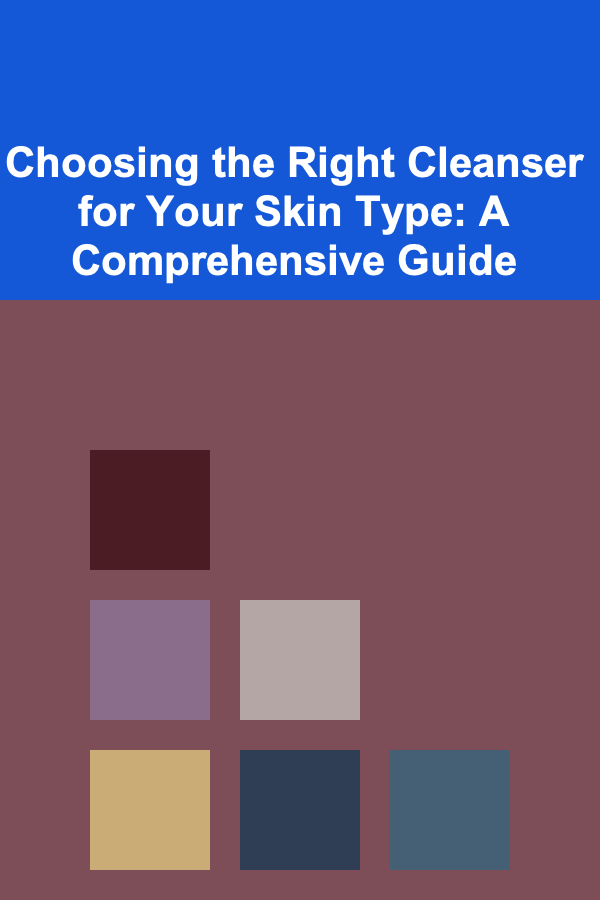
Choosing the Right Cleanser for Your Skin Type: A Comprehensive Guide
ebook include PDF & Audio bundle (Micro Guide)
$12.99$11.99
Limited Time Offer! Order within the next:

The foundation of any effective skincare routine lies in proper cleansing. While seemingly a simple step, choosing the right cleanser can make a world of difference in the health and appearance of your skin. A cleanser that's too harsh can strip away essential oils, leading to dryness and irritation, while one that's too gentle might not effectively remove dirt, makeup, and excess sebum, resulting in clogged pores and breakouts. Navigating the vast array of cleansers on the market can be overwhelming, but understanding your skin type and its specific needs is the key to making an informed decision. This comprehensive guide will walk you through the process of identifying your skin type and selecting the cleanser that will leave your skin clean, balanced, and radiant.
Understanding Your Skin Type: The Foundation of Cleanser Selection
Before diving into the world of cleansers, it's crucial to accurately identify your skin type. Skin types are generally categorized into five main categories: normal, oily, dry, combination, and sensitive. Understanding your skin type allows you to select products specifically formulated to address its unique characteristics and needs.
1. Normal Skin
Normal skin is often considered the "ideal" skin type, characterized by a balanced level of oil production and moisture. It's typically smooth, even-toned, and less prone to breakouts, sensitivity, or dryness. The pores are usually small and barely visible.
Characteristics of Normal Skin:
- Balanced oil production
- Small, barely visible pores
- Smooth texture
- Even skin tone
- Minimal sensitivity
- Infrequent breakouts
2. Oily Skin
Oily skin is characterized by excessive sebum production, which can lead to a shiny appearance, enlarged pores, and a higher susceptibility to breakouts, including acne, blackheads, and whiteheads. The T-zone (forehead, nose, and chin) is typically the oiliest area.
Characteristics of Oily Skin:
- Excessive sebum production
- Shiny appearance, especially in the T-zone
- Enlarged pores
- Frequent breakouts (acne, blackheads, whiteheads)
- May feel greasy to the touch
3. Dry Skin
Dry skin lacks sufficient moisture and oil, resulting in a tight, flaky, and sometimes itchy complexion. It can be caused by genetics, environmental factors (such as cold weather or low humidity), or certain skincare habits (like over-exfoliating). Dry skin is more prone to fine lines and wrinkles.
Characteristics of Dry Skin:
- Tightness and discomfort
- Flakiness or scaling
- Itching or irritation
- Visible fine lines and wrinkles
- Dull appearance
- May feel rough to the touch
4. Combination Skin
Combination skin is a mixture of oily and dry areas, typically with an oily T-zone and dry cheeks. This skin type can be challenging to manage because different areas require different types of care.
Characteristics of Combination Skin:
- Oily T-zone (forehead, nose, chin)
- Dry cheeks
- Enlarged pores in the T-zone
- Occasional breakouts
- May experience both dryness and shine
5. Sensitive Skin
Sensitive skin is prone to irritation, redness, itching, and stinging in response to certain products or environmental factors. It's often associated with underlying skin conditions like eczema or rosacea, but can also occur in individuals with otherwise healthy skin.
Characteristics of Sensitive Skin:
- Redness and inflammation
- Itching or stinging
- Dryness or flakiness
- Reaction to fragrances, dyes, and other irritants
- May be prone to allergic reactions
- Thin and delicate skin
Choosing the Right Cleanser: A Guide for Each Skin Type
Now that you've identified your skin type, let's explore the best cleanser options for each:
1. Cleansers for Normal Skin
Individuals with normal skin have the most flexibility in choosing a cleanser. The goal is to maintain the skin's natural balance without stripping away essential oils or causing dryness. Look for cleansers that are:
- Gentle and pH-balanced: These cleansers effectively remove dirt and impurities without disrupting the skin's natural barrier.
- Cream-based or gel-based: Both cream and gel cleansers can work well for normal skin. Cream cleansers provide a bit more moisture, while gel cleansers offer a lighter feel.
- Formulated with hydrating ingredients: Look for ingredients like hyaluronic acid, glycerin, or ceramides to help maintain moisture levels.
- Avoid harsh ingredients: Steer clear of cleansers containing sulfates, alcohol, or strong fragrances, as these can cause irritation.
Recommended Cleanser Types for Normal Skin:
- Gentle Cream Cleansers: Provide mild cleansing and hydration.
- Hydrating Gel Cleansers: Offer a lighter feel while maintaining moisture.
- Foaming Cleansers (used sparingly): Can be used occasionally, but choose a mild formula.
Ingredients to Look For:
- Hyaluronic Acid: A powerful humectant that draws moisture to the skin.
- Glycerin: Another effective humectant that helps to hydrate and soften the skin.
- Ceramides: Lipids that help to strengthen the skin's barrier and prevent moisture loss.
- Aloe Vera: Soothes and hydrates the skin.
- Vitamin E: An antioxidant that helps to protect the skin from damage.
2. Cleansers for Oily Skin
The primary goal for oily skin is to effectively remove excess sebum and prevent clogged pores without over-drying the skin. Over-drying can actually trigger the skin to produce even more oil, leading to a vicious cycle. Look for cleansers that are:
- Foaming or gel-based: These formulas are typically more effective at removing oil and impurities.
- Oil-free: Avoid cleansers that contain oils or emollients, as these can contribute to clogged pores.
- Non-comedogenic: This means the cleanser is formulated to not clog pores.
- Contain ingredients that help to control oil production: Salicylic acid and benzoyl peroxide are common ingredients used to treat acne and oily skin.
- Avoid harsh ingredients: While you need a cleanser that effectively removes oil, avoid those that are too stripping or drying, as this can lead to irritation and increased oil production.
Recommended Cleanser Types for Oily Skin:
- Foaming Cleansers: Effectively remove oil and impurities.
- Gel Cleansers: Provide a lighter feel while controlling oil production.
- Clay Cleansers: Absorb excess oil and purify pores (use 1-2 times per week).
Ingredients to Look For:
- Salicylic Acid (BHA): A beta-hydroxy acid that exfoliates the skin and unclogs pores.
- Benzoyl Peroxide: An antibacterial ingredient that kills acne-causing bacteria. (Use with caution and start with a low concentration to avoid irritation.)
- Tea Tree Oil: A natural antiseptic with anti-inflammatory properties.
- Niacinamide: Helps to control oil production, reduce inflammation, and minimize pores.
- Charcoal: Absorbs excess oil and impurities.
Important Considerations for Oily Skin:
- Don't over-wash: Washing your face too frequently can strip the skin of its natural oils, leading to increased oil production. Twice a day is usually sufficient.
- Use lukewarm water: Hot water can be drying and irritating.
- Pat your skin dry: Rubbing your skin can stimulate oil production.
3. Cleansers for Dry Skin
The key to cleansing dry skin is to replenish moisture and avoid stripping away natural oils. Look for cleansers that are:
- Cream-based or oil-based: These formulas are more gentle and hydrating than foaming cleansers.
- Soap-free: Traditional soaps can be very drying.
- Formulated with moisturizing ingredients: Look for ingredients like hyaluronic acid, glycerin, ceramides, and natural oils.
- Fragrance-free: Fragrances can be irritating to dry skin.
- Avoid harsh ingredients: Steer clear of sulfates, alcohol, and strong exfoliants.
Recommended Cleanser Types for Dry Skin:
- Cream Cleansers: Provide gentle cleansing and hydration.
- Oil Cleansers: Effectively remove makeup and impurities without stripping the skin.
- Cleansing Balms: Melt away makeup and leave the skin feeling soft and supple.
Ingredients to Look For:
- Hyaluronic Acid: A powerful humectant that draws moisture to the skin.
- Glycerin: Another effective humectant that helps to hydrate and soften the skin.
- Ceramides: Lipids that help to strengthen the skin's barrier and prevent moisture loss.
- Shea Butter: A rich emollient that nourishes and protects the skin.
- Jojoba Oil: A natural oil that closely resembles the skin's own sebum.
- Avocado Oil: A hydrating and antioxidant-rich oil.
Important Considerations for Dry Skin:
- Wash your face less frequently: Once a day, preferably at night, may be sufficient.
- Use lukewarm water: Hot water can be drying and irritating.
- Pat your skin dry: Rubbing your skin can exacerbate dryness.
- Apply moisturizer immediately after cleansing: This helps to lock in moisture.
4. Cleansers for Combination Skin
Choosing a cleanser for combination skin requires finding a balance between effectively cleansing oily areas and hydrating dry areas. Look for cleansers that are:
- Gentle and pH-balanced: To avoid irritating dry areas.
- Formulated to address both oil and dryness: Some cleansers are specifically designed for combination skin.
- Gel-based or mild foaming cleansers: These formulas can effectively cleanse the T-zone without over-drying the cheeks.
- Consider using different cleansers for different areas: You may want to use a slightly stronger cleanser on your T-zone and a more hydrating cleanser on your cheeks.
- Avoid harsh ingredients: Steer clear of sulfates, alcohol, and strong fragrances.
Recommended Cleanser Types for Combination Skin:
- Gentle Gel Cleansers: Cleanse the T-zone without over-drying the cheeks.
- Mild Foaming Cleansers: Offer a deeper clean for oily areas.
- Cream-to-Foam Cleansers: Start as a cream to provide hydration and then gently foam to cleanse.
Ingredients to Look For:
- Hyaluronic Acid: Hydrates dry areas without making oily areas greasy.
- Glycerin: Another effective humectant.
- Niacinamide: Helps to control oil production and reduce inflammation.
- Salicylic Acid (BHA): Can be used sparingly on the T-zone to unclog pores.
- Green Tea Extract: An antioxidant with anti-inflammatory properties.
Important Considerations for Combination Skin:
- Focus on cleansing the T-zone: Pay extra attention to cleaning the oily areas to prevent breakouts.
- Hydrate dry areas: Use a rich moisturizer on your cheeks after cleansing.
- Consider using a toner: A toner can help to balance the skin's pH and remove any remaining impurities. Choose a toner appropriate for combination skin, focusing on one that is alcohol-free.
5. Cleansers for Sensitive Skin
The most important consideration for sensitive skin is to avoid irritation and inflammation. Look for cleansers that are:
- Extremely gentle and hypoallergenic: Formulated to minimize the risk of allergic reactions.
- Fragrance-free and dye-free: Fragrances and dyes are common irritants for sensitive skin.
- Soap-free: Traditional soaps can be very drying and irritating.
- Cream-based or oil-based: These formulas are more gentle and hydrating than foaming cleansers.
- Formulated with soothing ingredients: Look for ingredients like aloe vera, chamomile, and oatmeal.
- Dermatologist-tested: Ensures the cleanser has been tested for safety and sensitivity.
- Minimal ingredients: Look for formulations with short ingredients lists. The fewer ingredients, the less likely you are to react to something.
Recommended Cleanser Types for Sensitive Skin:
- Cream Cleansers: Provide gentle cleansing and hydration.
- Oil Cleansers: Effectively remove makeup and impurities without stripping the skin.
- Micellar Water: A gentle cleansing water that doesn't require rinsing.
Ingredients to Look For:
- Aloe Vera: Soothes and hydrates the skin.
- Chamomile: Reduces inflammation and calms the skin.
- Oatmeal: Soothes and relieves itching.
- Glycerin: A humectant that helps to hydrate the skin.
- Ceramides: Strengthen the skin's barrier and prevent moisture loss.
Ingredients to Avoid:
- Fragrances: A common cause of irritation.
- Dyes: Another potential irritant.
- Sulfates (SLS, SLES): Harsh detergents that can strip the skin of its natural oils.
- Alcohol: Can be drying and irritating.
- Essential Oils: While natural, some essential oils can be irritating to sensitive skin.
- Exfoliating Acids (AHAs, BHAs): May be too harsh for sensitive skin. If you want to exfoliate, start with a very low concentration and use sparingly.
Important Considerations for Sensitive Skin:
- Patch test new products: Apply a small amount of the cleanser to a discreet area of skin (like behind your ear) and wait 24-48 hours to see if any irritation develops.
- Wash your face gently: Avoid scrubbing or rubbing your skin.
- Use lukewarm water: Hot water can be irritating.
- Pat your skin dry: Rubbing your skin can exacerbate irritation.
- Apply moisturizer immediately after cleansing: This helps to lock in moisture and protect the skin barrier.
Beyond Skin Type: Other Factors to Consider
While understanding your skin type is essential, there are other factors to consider when choosing a cleanser:
1. Skin Concerns
Do you have specific skin concerns like acne, hyperpigmentation, or aging? Look for cleansers that contain ingredients to address these concerns. For example:
- Acne: Cleansers containing salicylic acid, benzoyl peroxide, or tea tree oil.
- Hyperpigmentation: Cleansers containing vitamin C or glycolic acid (use with caution on sensitive skin).
- Aging: Cleansers containing antioxidants like vitamin E or green tea extract.
2. Lifestyle
Your lifestyle can also influence your cleanser choice. If you wear heavy makeup, you may need a cleanser that's effective at removing makeup without stripping your skin. If you exercise regularly, you may need a cleanser that can remove sweat and dirt effectively.
3. Seasonal Changes
Your skin's needs may change with the seasons. In the winter, your skin may become drier, so you may need a more hydrating cleanser. In the summer, your skin may become oilier, so you may need a more oil-controlling cleanser.
4. Personal Preferences
Ultimately, the best cleanser for you is one that you enjoy using and that leaves your skin feeling clean and comfortable. Experiment with different formulas and textures to find what works best for you.
How to Patch Test a New Cleanser
Before incorporating a new cleanser into your regular routine, it's crucial to perform a patch test, especially if you have sensitive skin. This simple process helps identify potential allergic reactions or irritations before they become widespread. Here's how to do it:
- Choose a discreet area: Select a small, inconspicuous area of skin, such as the inside of your wrist, behind your ear, or on your inner arm.
- Apply a small amount: Apply a pea-sized amount of the cleanser to the chosen area.
- Cover the area (optional): If you suspect the cleanser may be particularly irritating, you can cover the area with a bandage. This can help to intensify the reaction, if any.
- Wait 24-48 hours: Leave the cleanser on for 24-48 hours, observing the area for any signs of irritation, such as redness, itching, burning, swelling, or a rash.
- Monitor for delayed reactions: Even if you don't experience an immediate reaction, continue to monitor the area for several days, as some reactions may be delayed.
- Rinse thoroughly: If you experience any irritation, rinse the cleanser off immediately with lukewarm water and discontinue use.
- If no reaction occurs: If you experience no adverse reactions after 48 hours, it's generally safe to assume that you're not allergic or sensitive to the cleanser. You can then gradually incorporate it into your regular skincare routine.
Final Thoughts
Choosing the right cleanser is an essential step in achieving healthy, radiant skin. By understanding your skin type, considering your specific skin concerns, and paying attention to the ingredients in your cleanser, you can find the perfect formula to keep your skin clean, balanced, and beautiful. Remember to always patch test new products and consult with a dermatologist if you have any concerns or persistent skin issues. Finding the right cleanser might involve some experimentation, but the effort is well worth it for the sake of your skin's health and appearance.

How to Avoid Emotional Investing and Stick to Your Plan
Read More
How to Create an Inspiring Workout Environment
Read More
How to Evaluate and Choose the Right Software Tools
Read More
How to Organize Outdoor Toys for Easy Access
Read More
How to Plan Your Home Budget Around Seasonal Expenses
Read More
How To Master Nail Art for Beginners
Read MoreOther Products

How to Avoid Emotional Investing and Stick to Your Plan
Read More
How to Create an Inspiring Workout Environment
Read More
How to Evaluate and Choose the Right Software Tools
Read More
How to Organize Outdoor Toys for Easy Access
Read More
How to Plan Your Home Budget Around Seasonal Expenses
Read More